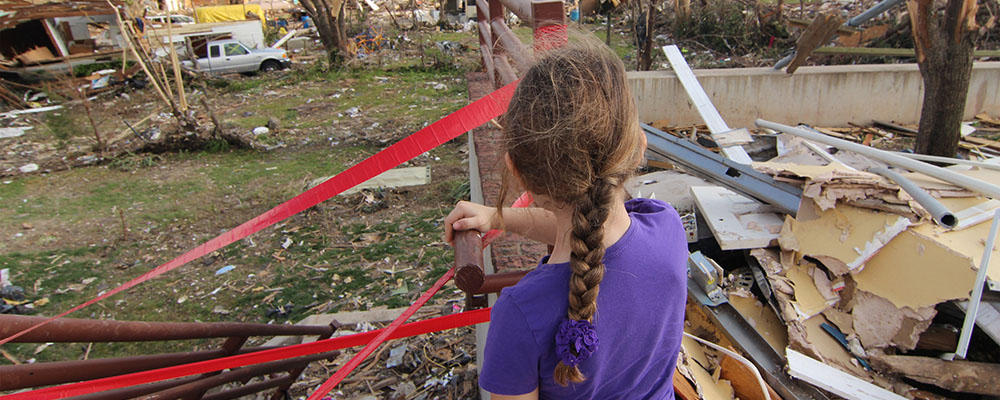 A child looks out over the wreckage of the Joplin Tornado on May 22, 2011. Photo Credit: Dustie, 2011.
A child looks out over the wreckage of the Joplin Tornado on May 22, 2011. Photo Credit: Dustie, 2011.
By Betty Lai, Annette La Greca, and Ann-Margaret Esnard
Implications for Public Health
Screen children to identify those experiencing elevated post-traumatic stress symptoms and then identify sources of social support and coping strategies.
Frightening flashbacks, recurring nightmares, the inability to focus at school—up to 70 percent of children who experience disasters will show post-traumatic stress symptoms such as these in the first three months. Left untreated, symptoms can become chronic in some children.
There are treatments to reduce post-traumatic stress symptoms, but many such measures are too resource intensive to offer to every affected child after a large-scale disaster. And studies consistently show that the majority of affected children may not need these resource-intensive treatments.
How can we know who needs intensive treatment and who will recover without it? How do we allocate resources so that we’re providing the right level of care to match the needs of each child?
We reviewed eight rigorous studies that included more than 8,000 children between ages 3 and 18 and found some potential answers. Researchers examining adults have found four categories of reactions to disasters that would be considered typical: chronic (high levels of symptoms that stay high over time), recovery (symptoms that start high but decline over time), delayed (symptoms that start low but increase over time), and resilience (symptoms that start low and remain low over time).
With children, we found that there wasn’t much evidence of delayed symptoms of post-traumatic stress. This was surprising because delayed symptoms have often been found in research with adults. In addition, most children were resilient and either never reported high levels of symptoms, or recovered over time from their initial distress.
A very small number of children across the studies reported chronic symptoms following disaster. Importantly, these children differed from those who recovered over time in that they were more likely to have low levels of social support, more negative coping skills, and more stressful ongoing life events.
What does this mean for helping children after disasters? It means that while early symptoms don’t necessarily show the full picture of how a child will do over time, we don't need to worry too much that children who don't show symptoms early on will suddenly become symptomatic later. It is the children who report very high levels of distress in the first three months, and who also lack social support, have poor coping skills, or continue to experience stress, who are not likely to improve on their own.
Therefore, we need to screen children soon after a disaster to figure out which children report high levels of symptoms that interfere with their lives—as well as which children lack support and are having trouble coping with stress—since these children’s symptoms can continue in the long-term.
To address these issues, schools and public health officials should screen children to identify those experiencing elevated post-traumatic stress symptoms and to determine sources of social support and coping strategies. Schools are an ideal site for conducting screenings, since most children attend school and schools have established relationships with children and families. Screenings should be conducted after children’s basic needs have been met, an implementation team is convened, and resources for children experiencing distress have been identified.
The National Child Traumatic Stress Network developed guidelines for screening and assessment related to trauma and children’s mental health. For children who report distress but don’t need an intensive intervention, Annette La Greca and 7-Dippity Inc. have developed After the Storm, a guide to help children cope with the effects of disasters.
Although many children will bounce back after disasters, some will need more targeted help to cope with their feelings of distress. Working to identify those children early is an important step to helping them move beyond the impact of natural disaster and toward adjustment and healthy quality of life.
Suggested Tools
After the Storm
Annette La Greca, University of Miami; Scott Sevin and Elaine Sevin, 7-Dippity
Guide to help children cope with the psychological effects of a hurricane.
Trauma-Informed Mental Health Assessment
National Child Traumatic Stress Network
Guidelines for screening and assessment related to trauma and children’s mental health.
For a list of all the tools included in this special collection, visit the Children and Disasters Tool Index.

Betty Lai is the Buehler Sesquicentennial Assistant Professor at Boston College. Her work focuses on helping children prepare for, respond to, and adapt to stressors and adverse events. She has identified factors that place children at risk for negative outcomes and factors that help youth be more resilient. She and her colleagues are also examining how adverse events may impact schools. She is working to provide recommendations for how schools may prepare for such events and how they can support their communities.